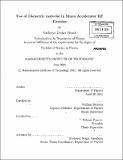| dc.contributor.advisor | William Barletta and Milorad Popovic. | en_US |
| dc.contributor.author | French, Katheryn Decker | en_US |
| dc.contributor.other | Massachusetts Institute of Technology. Dept. of Physics. | en_US |
| dc.date.accessioned | 2011-08-30T15:46:42Z | |
| dc.date.available | 2011-08-30T15:46:42Z | |
| dc.date.copyright | 2011 | en_US |
| dc.date.issued | 2011 | en_US |
| dc.identifier.uri | http://hdl.handle.net/1721.1/65530 | |
| dc.description | Thesis (S.B.)--Massachusetts Institute of Technology, Dept. of Physics, 2011. | en_US |
| dc.description | Cataloged from PDF version of thesis. | en_US |
| dc.description | Includes bibliographical references (p. 65-67). | en_US |
| dc.description.abstract | The building of a muon collider is motivated by the desire to collide point-like particles while reducing the limitations imposed by synchrotron radiation. The many challenges unique to muon accelerators are derived from the short lifetime of the muons. The muons must be produced, then formed into a beam and accelerated to their final energy in less than a few milliseconds in the lab frame. One idea for accomplishing this is called a helical cooling channel (HCC), and requires placing the accelerating structure in a solenoid. The RF (radio frequency) accelerating structure in a muon accelerator should be short in the longitudinal direction, small enough in the transverse direction to fit inside the solenoids of the helical cooling channel, and have the highest possible electric field gradient. A RF cavity that meets these requirements is crucial to the development of a muon collider. There is an additional constraint if an existing source of RF power is to be used, as the frequency of the lowest RF cavity mode should match the frequency of the power source. At Fermilab, the klystrons produce RF power at 800MHz. The resonant frequency of an RF cavity depends inversely on the radius of the cavity, as well as the dielectric constant of the material within the cavity. A standard vacuum cavity with a resonant frequency of 800 MHz is too large to fit within the solenoids. This paper studies one method of avoiding this limitation by placing a dielectric material within the cavity. Another problem faced by a cavity within an HCC is the effect of the magnetic field. The solenoid field will serve to focus electrons emitted from the sides of the cavity, causing breakdown at lower electric fields than those possible without the solenoid. By inserting the dielectric at a high electric field point, electrons emitted from the wall behind the dielectric will be attenuated before they can avalanche and cause breakdown. The effect of this dielectric is modeled in Microwave Studio to determine the right size and shape for the dielectric given, and several prototype cavities are built and tested with a network analyzer. Our proof of concept experiment shows the feasibility of further developing the design of dielectric loaded RF cavities. A design for a cavity to be used at higher power is discussed, along with the testing procedures that will be followed. | en_US |
| dc.description.statementofresponsibility | by Katheryn Decker French. | en_US |
| dc.format.extent | 67 p. | en_US |
| dc.language.iso | eng | en_US |
| dc.publisher | Massachusetts Institute of Technology | en_US |
| dc.rights | M.I.T. theses are protected by
copyright. They may be viewed from this source for any purpose, but
reproduction or distribution in any format is prohibited without written
permission. See provided URL for inquiries about permission. | en_US |
| dc.rights.uri | http://dspace.mit.edu/handle/1721.1/7582 | en_US |
| dc.subject | Physics. | en_US |
| dc.title | Use of dielectric material in muon accelerator RF cavities | en_US |
| dc.title.alternative | Use of dielectric material in muon accelerator radio frequency cavities | en_US |
| dc.type | Thesis | en_US |
| dc.description.degree | S.B. | en_US |
| dc.contributor.department | Massachusetts Institute of Technology. Department of Physics | |
| dc.identifier.oclc | 746880232 | en_US |
